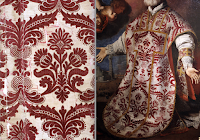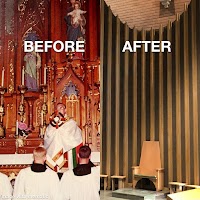 Continuing on with our popular before and after series, we turn today to a project executed in part by Murals by Jericho who are located in Peoria, Illinois. They recently pursued work at St. Leo the Great Catholic Church in Demopolis, Alabama. They offer the following comm…
Continuing on with our popular before and after series, we turn today to a project executed in part by Murals by Jericho who are located in Peoria, Illinois. They recently pursued work at St. Leo the Great Catholic Church in Demopolis, Alabama. They offer the following comm…
Our Advertising Partners
-
The global pandemic has disrupted the normal celebration of the Holy Week in Spain, where, for a second year, the government has forbidden t...
-
We live in a very visual, image-based culture and, what's more, there is always lots of curiosity around the matter of traditional papal...
-
Above is an image of Pope John XXIII after his death in 1963, dressed in red vestments for burial (the arms on the front of the chasuble app...
-
The mitre is one of the most recognizable symbols of prelates of the Church, specifically of bishops up to the Roman pontiff himself -- thou...
-
The papal blessing known as the Benedictio Coram Populo, or more commonly as the Urbi et Orbi (to the city [of Rome] and to the world) bless...
-
To the person who simply enjoys beautiful art and architecture, distinctions like "baroque" or "rococo" might seem overl...
Blog Archive
-
▼
2021
(258)
-
▼
December
(23)
- Before and After: St. Leo the Great, Demopolis, Al...
- A Rare Glimpse: Painting and Reality
- A Newly Carved Tintinnabulum and Umbraculum
- Book Review: "Death Comes for the Cathedrals" by M...
- Belmont Abbey Basilica Renovation (1964-1965)
- A New Renaissance Style Triptych
- A Nineteenth Century Cope from the Cathedral of Se...
- The Lindau Gospels Treasure in New York
- Noble Simplicity Versus Post-Conciliar Sanctuary C...
- New Masterpiece Polyptych for Diocese of Charlotte...
- A Brief Survey of the Old Testament in Sacred and ...
- Some Views of the Patriarchal Basilica of St. Mark...
- New Altar Cards in the Medieval Tradition
- Liturgical Variations: The Placement of the Deacon...
- Another Case Study in the Noble Beauty and Simplic...
- The Basilica of Santa Maria Sopra Minerva: What Is...
- The Ambrosian Rite's Unique Liturgical Colour: Mor...
- The Spanish Privilege: Cerulean Blue and the Immac...
- Two Unique Examples of Reversible Vestments
- Customs and Traditions: Sinterklaas (The Feast of ...
- The Tree of Jesse in Sacred Art
- Other Modern: Basilica of Sainte-Thérèse de Lisieu...
- Renaissance Velvets in Vestments
-
►
November
(22)
- St. Agnes Convent Chapel Renovation by Noble Inter...
- Varieties of Violacea Found in the Sixteenth Century
- Four Altar Candlesticks from the Sixteenth Century
- An Antependium for Good Friday
- Development in Vestment Design: An Example
- The American Transformation of the Advent Wreath
- Symbols in Vestment Design: Some Design Considerat...
- What's in a Painting? A Small Window into the Litu...
- The History and Forms of the Christian Altar: The ...
- Some Historic Churches of Québec
- Vestments of Cardinal Prospero Lorenzo Lambertini ...
- The "Parato Ciceri" - Paraments of Cardinal Carlo ...
-
▼
December
(23)
Donate
Copyright ©
Liturgical Arts Journal | Powered by Blogger



















































